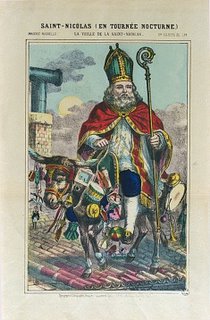Ante Diem VIII Idus December

Modern Date : December 6th
Ante Diem VIII Idus December
Eighth Day to the Ides of December
This is one of the dies fasti on which legal actions are permitted.
The Faunalia
The festivities of the Faunalia continued on this day. This festival was more popularly celebrated in rustic areas, being a celebration of nature and animals. The people celebrated this festival with a dance done in triple measure, the same dance done by the priests of Salii, the priests of Mars. Faunus was the grandson of Cronus (Saturn). He was worshipped as the god of fields and sheperds, and as a prophetic god.
Decima, the middle Fate in charge of the present, presides over December, but the month may have received its name as the tenth month of the Roman calendar. Vesta, patroness of fire also laid claim to the month of December.
St. Nicholas
In the Roman Catholic calendar, feast of St. Nicholas, healer and miracle worker, patron saint of Russia. To this day his relics at the church in Bari, Italy are said to yield a "manna" that heals the sick and infirm. In northwest Europe and North America, he is more closely identified with Santa Claus, whose highly dualistic system of giving gifts -- toys for kids who obey, coal for those who don't -- encourages children to be good in December, during the mellowness of the harvest season, when yelling is least welcome and pleasant.
How this 4th century Bishop of Myra became Santa Claus is somewhat of a mystery. Nicholas was a fourth century Bishop in Turkey who reportedly saved three young girls from being sold into slavery by their destitute father. Three bags of gold allowed them to marry honorably. He was also said to have resurrected three dead school boys and so is considered the patron of youth. In Northern Europe, St. Nicholas absorbed the pagan qualities of Odin, riding through the sky with reindeer and forty-two supernatural huntsmen. Later he was merged with Father Christmas of Yuletide, creating the modern Santa Claus who was also influenced by elements of Thor.
St Nicholas in winter sends the horses to the stable
St Nicholas in spring makes them fat.
(Russian proverb)
He is also the patron of thieves, because his bones were ripped off (in 1087 by Italian merchants who took his body to Bari, Italy).
Another legend tells how he begged some grain from a ship passing through Myra during a famine. He kept some and baked the rest as bread, in his shape. Thus he is the patron of sailors and bakers. And perhaps the creator of gingerbread men.
His legends spread throughout the world rapidly during the Middle Ages. During the ninth century, the Russians, who heard his stories in Constantinople, adopted him as a patron of Russia; his name became popular for nobles and czars. During the eleventh century, the Normans of Italy took his story to Normandy and England. He is also the patron of Greece. The French say the Virgin gave him the province of Lorraine as a reward.
Helen Farias notes that he has many of the characteristics of ocean deities like Poseidon, whose month this is. It's possible that his figure was merged in the northern countries with that of Woden. Old Nick is another name for Woden, who like the Celtic Holly King, is the lord of the dead. St Nick is often pictured riding a white horse like Odin's Sleipnir.
In Austria, St Nicholas makes his rounds in glittering bishop's robes. He has a long white beard and carries a pastoral staff. While St. Nicholas rewards good children with nuts and sweets, naughty youngsters are taunted with a switch from his black-faced servant. In some parts of Austria, St Nicholas is accompanied by the Laubauf, a horned monster. In Styria, the dark companion is called Bartlel, in lower Austria, Krampus or Grampus. In Czechoslovakia, St Nicholas is accompanied by an Angel and a Devil. In the Netherlands, he is accompanied by Zwartse Piet or Black Peter, the Moor. (A similar figure appears in Mummers’ plays, a convenient enemy from the historical time when the Crusaders were fighting the heathens.) In France, even the goods kids get little bunches of birch twigs, tied with ribbon.
In Italy and Greece, it is the sailors more than the children who celebrate the saint’s day. Greek sailors light a candle before the icon of St Nicholas found on every ship and say prayers for safe passage. In Bari, Italy, the image of St Nicholas is placed in a boat decorated with flowers and banners which is taken far out to sea, then returned to its shrine at night.
St. Nicholas has his own special cookie: the Speculatius, a gingerbread figure of a bishop. The name means “image,” referring to the mirror image of St Nicholas which has been pressed into a wooden mold and then turned out on a sheet to bake in the oven (like other traditional Christmas cookies made in molds: springerle and cavalucci).
In the Netherlands, St Nicholas brings treats like taai-taai, crisp ginger cakes baked in traditional patterns, sweet chocolate letters, pink and white candy hearts, hard spiced cakes and the initials of the child’s name baked in pastry, letterbanket, filled with rich almond paste. Roast goose is the traditional food for the evening feast, along with marvelous cakes baked in the shape of St Nicholas, birds, fish and fantastic animals. In Bulgaria, sharan, a special kind of fish is served with rice and a ceremonial bread.
The Nicolaites, Gnostic followers of St. Nicholas, taught that the way to salvation was through frequent sexual intercourse.

0 Comments:
Post a Comment
<< Home